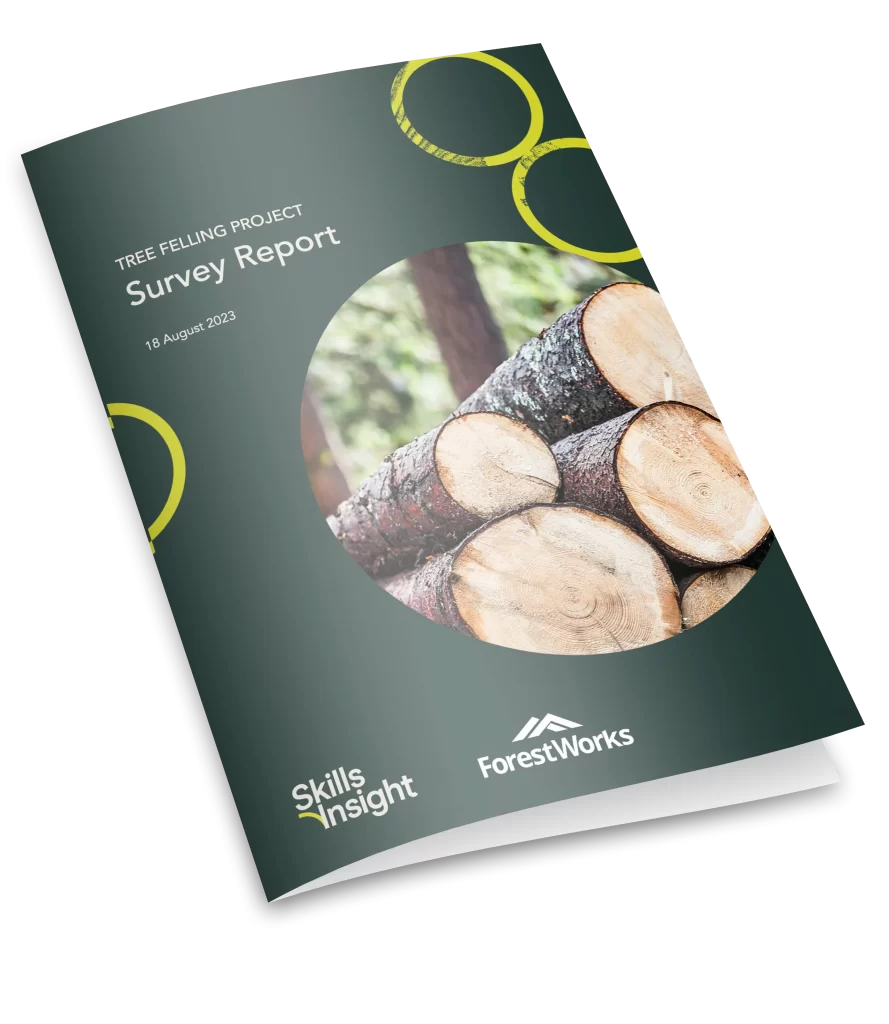Using a chainsaw to fell trees is a crucial skill in forestry operations, agriculture and arboriculture, as well as in emergency events like storms, cyclones and bushfires. Manual tree felling skills are essential for removing trees in locations or positions that make the use of large machinery unviable. This skill may also be required in environments such as development, construction, landscaping, and parks and gardens.
Click across the tabs to view active and completed project stages. Consultation takes place at every stage of the project.
These skills are described in three units of competency which specifically outline the number of trees required to be felled in order to demonstrate competence at a basic, intermediate and advanced level.
Some training providers have indicated that the number of trees required at each unit level has an impact on their ability to deliver training, as practice trees can be difficult to source outside of a forestry environment. It is crucial that these units are accessible to train, so that everyone who performs tree felling work can access formal training. This must be balanced with the need for learners to demonstrate felling techniques many times, so they have the skills and confidence to perform the task safely in the field.
Subscribe for updates
If you would like to receive updates about this project, please subscribe to our newsletter and select ‘forestry and timber’ as one of your industries of interest.
In 2022 the tree felling units were reviewed as part of the broader Responding and Assisting in Bushfires Project and updated to reflect feedback about accessibility of training. Further industry and training provider feedback has indicated a need to reexamine the units, so that they can best support the safety and competence of all learners. Consultation will take place throughout this project to review the three tree felling units and consider how many trees are required to demonstrate each skill level and what other mechanisms may be needed to support safety and competency.
In devising solutions, consideration will be given to safety standards, accessibility of resources, competency development and training resources.
Units to be reviewed:
- FWPCOT2274 Fell trees manually (basic)
- FWPCOT3347 Fell trees manually (intermediate)
- FWPCOT3348 Fell trees manually (advanced)
Relevant Occupations
The occupations relevant to this project are workers that use chainsaws to fell trees including forestry workers, arboriculture workers, gardeners, farm workers and authorised personnel within fire services, state emergency services and parks and wildlife services.
A Note About Teach out Periods
We are aware the teach out period for FWP20121 Certificate II in Forest Operations and FWP30121 Certificate III in Forest Operations ends in December this year. These qualifications contain superseded versions of the tree felling units, which have been recommended for use while the current units are being considered for update as part of this project. A 12-month extension to the teach out period has been sought from the Australian Skills Quality Authority, so RTOs will still be able to train these units while the project is underway. This application is currently being processed by the Australian Skills Quality Authority.
Timeline

Project Team

Georgiana Daian
Project Manager, ForestWorks [email protected]

Paul Cavicchia
Cross Functional Team Member, ForestWorks [email protected]
Subject Matter Experts
Subject Matter Experts (SME) will be drawn on throughout this project to help review and draft the revised units of competency.
If you are interested in applying to be a subject matter expert and are able to volunteer your time to this project, please email details of your expertise to [email protected]
Opportunities for stakeholder input
The project team invites input on potential solutions to the outlined challenges. Key areas of focus include safety, efficiency and sustainability with respect to training delivery and skills assessment.
Suggestions so far from interested stakeholders have included:

Extensive training prior to assessment
Stakeholders stress the need for comprehensive training before students are evaluated for competence in felling live trees. Assessment should only occur once a trainer is confident there is no risk to the student.

User Guides for units
Development of support guides to help training providers implement the units safely has been suggested.

Prerequisite Units
Recommendations have been made to include the basic (foundational) tree felling unit as prerequisite for advanced ones. Candidates should have robust knowledge of chainsaw use and basic tree felling practices before they proceed to more advanced levels.

Partnership for Performance Evidence
Training providers could leverage third parties (employer/supervisor) to gather proof of student performance from their workplaces. This envisages using live digital videos, video recordings, or third-party observations and does not necessarily require an assessor’s physical presence.

Virtual Reality and Simulators for Immersive Learning
The use of virtual reality and simulators has been suggested to complement traditional methods by allowing students to practice various and dangerous tree felling situations in a secure environment.
These and other suggestions will be assessed in detail with subject matter experts during the development stage in August and September in preparation for broad industry consultation in October.
Stakeholder input is appreciated throughout the duration of this project. The units will be drafted in consultation with subject matter experts and their networks. Opportunities to provide targeted feedback will occur when the draft materials are made available in October 2023, and again for validation of final drafts in November 2023. However, your feedback is welcomed at any time, and will help us in drafting the units. It is important that training provides a skilled and flexible workforce for the future. The units need to reflect real work experience. So if you work in the sector, Skills Insight would love your input and help. Please feel free to register your interest in project updates and consultation opportunities by following the newsletter subscription link above. Alternatively, please feel free to contact the project manager, Georgiana Daian on 03 9321 3519 or [email protected].
Stakeholder Consultation Process
A list of key stakeholder organisations has been identified for this project. Skills Insight and ForestWorks will ensure contact is made with each of these organisations during the development of this project to seek their involvement and their views on the draft units. Consultation is not limited to the organisations on this list. This list simply helps us to identify those organisations that, because of their industry role, size or specialty, are likely to have a key interest in the development and outcomes of this project.
If you are aware of an organisation that you think should be involved, please contact the project team to ensure they are contacted by us.
Of course, all and any interested industry participants are encouraged to engage in the consultation of this project, when the draft units are available for feedback via this webpage and workshops that take place.
This project is part of the 2022-23 Annual Training Product Development Plan.
The skills for felling trees using a chainsaw are described in three units of competency at a basic, intermediate and advanced level, which specifically outline the number of trees required to be felled to demonstrate competence.
Feedback from some training providers has indicated that the number of trees required at each unit level is a barrier to training as they are difficult to source. It is important these units are accessible to train, so that everyone who performs tree felling work can access formal training. However, it is also vital that learners experience the most effective approach to teaching and assessing so that they are equipped with skills to operate safely in a wide range of conditions.
Stakeholders including trainers and industry are being consulted to review the three tree felling units and consider how many trees are required to demonstrate each skill level and what other mechanisms may be needed to support safety, accessibility, and competency.

A survey was conducted from 7 to 11 August to gain deeper insights into the challenges faced by Registered Training Organisations (RTOs) in sourcing the required number of trees.
All 127 RTOs that have at least one of these units in their scope of registration were invited to participate in the survey. The survey received responses from 53 individuals, representing 38 organisations.
Of respondents, 68% reported challenges in acquiring the required number of trees. Within this group, 42% managed to overcome these challenges but noted that the issues persist and continue to impact them. The remaining 26% indicated that they faced difficulties specifically in executing the actual training. Those who had no issues finding trees understood and empathised with the challenges of their peers.
Consistent themes emerged across RTOs and a range of solutions were proposed.
Download the full report on the survey results below to find out more about common themes and possible solutions.
Development Outcomes and Next Steps
In September, the project’s technical committee will engage in a sequence of workshops. The focus of these workshops will be to explore effective teaching strategies that highlight best practices, with particular attention to safety and tree efficiency.
In addition to this, the committee with consider progressive competency assessments and specific metrics which must be met by learners prior to cutting real trees. Recommendations for mentorships and work placements will also be part of these discussions.
The outcome of these discussions is anticipated to be the establishment of a comprehensive framework. This framework will encompass safety protocols, support the quality of training, and optimise efficiency in tree usage. This approach is intended to offer a structured and sustainable direction for revising the assessment criteria, specifically addressing the number of trees that must be cut to demonstrate competency.
Draft units and relevant documentation will be available on this webpage in October, giving other stakeholders an opportunity to provide feedback. Your input is welcome.
The three units that describe the skills for felling trees with a chainsaw specify a specific number of trees required for demonstrating competency. The number of trees required is important for the safety of learners but is increasingly presenting a barrier for training providers as environmental and heritage preservation measures make access to trees for this purpose more difficult.
In consultation with stakeholders, the three tree felling units were reviewed and updated where applicable to improve deliverability, while also supporting safety and competency. They were made available for review and feedback on this webpage from 17 October to 14 November 2023. Thank you to those who provided feedback during this time. Your input will be used to inform further updates to the drafts, which will be available for validation and comment shortly.
The basic and intermediate units were updated to decrease the number of trees required for assessment to 3 and 4 respectively. Chainsaw bar length specifications were added to both units and criteria to consider tree characteristics have been added to the intermediate unit. An introduction statement was also proposed to be added to both units, recommending individuals undertaking the unit have appropriate pre-existing skills.
For the advanced unit, the number of trees required for assessment was proposed to remain at 6 as described in the 2020 version [FWPFGM3217 Fell trees manually (advanced)], due to the complexity and higher risk when working with trees at this level. The statement recommending pre-existing skills and knowledge was already present in this unit.
A User Guide and a series of other recommendations were alsodrafted to promote safety for learners and address the issue of tree availability.
Factors guiding proposed unit changes

Safety first
Tree felling with a chainsaw carries inherent risks, requiring high quality training and assessment. While prioritising safety and proficiency, proposed changes to assessment criteria take into account the varying risk factors of felling trees at each skill level — from basic to advanced.

Holistic approach
Tree felling is perceived as an integrated process, rather than a series of isolated tasks. The proposed changes intend to maintain this holistic perspective.

Genuine Skill
Proposed changes consider the minimum number of trees needed for an assessor to reliably determine learner competency across diverse situations. It is important that learners can demonstrate manual tree felling skills across several attempts, so assessors can be confident they posses genuine skill, especially considering the high-risk nature of the activity.
Summary of consultation to date
In September, consultations with Subject Matter Experts (SMEs) were conducted to review the number of trees required for competency demonstration in each of the three tree felling units. These discussions also identified further ways to support safety. SMEs convened for three online meetings and numerous emails were exchanged.
Note on pre-existing skills statement
The introduction of prerequisite units for tree felling learners emerged as a significant safety measure proposed by SMEs to ensure learners embark on their training already equipped with essential skills and knowledge to support a safe training and assessment process.
After extensive discussions with the SMEs and a rigorous review with the Quality Assurance team regarding potential options for prerequisite units, it was determined that none of the available options are compliant with the Training Package Products Policy.
As an alternative, the SMEs agreed to integrate a statement in the Application sections of both the basic and intermediate units, emphasising the value of prior experience. Such a statement already exists in the advanced unit. Further explanation has also been provided in the Draft User Guide.
Online information sessions
Online information sessions were held to provide further details about changes to the units and how to provide feedback.
View Drafts and Provide Feedback
As part of this project, three tree felling units are being updated to improve deliverability while also supporting safety and competency. Consultation is taking place to determine an appropriate number of trees to demonstrate competent and safe tree felling at a basic, intermediate and advanced level, while also reducing barriers to training caused by limited availability of practice trees. The final draft units and User Guide were available on this webpage for validation and comment from 4 December to 17 December 2023.
Subject Matter Experts (SMEs) conducted a thorough review of all feedback received at the ‘Broad consultation’ stage. As a result, the number of trees to demonstrate competence at each level remained the same as proposed previously, specifically 3, 4 and 6 trees for the basic, intermediate, and advanced units, respectively. You can read more about the rationale for this decision below. The draft User Guide was also updated with further recommendations.
These improvements collectively support high standards of safety and robust assessment of competency, while reducing the barrier around availability of practice trees.
Summary of changes
The following improvements were made across all three units:
There has been an update on the equivalency status within the units. As a result of the changes made following industry consultation, the intermediate and advanced units will become not equivalent.
Information about the changes made to individual units is provided below.
Further details about feedback received during the ‘Broad Consultation’ stage and changes made in response are outlined in the ‘Summary of feedback’ document. Where feedback requests could not be implemented because they were outside the scope of this project, feedback will be carefully considered as part of our ongoing Workforce Plan, which guides our decisions on future initiatives.
Post-consultation Information Sessions
Online information sessions were held to provide further details about updates to the units following feedback from broad consultations, how to provide validation input, and what’s next as we move towards finalisation stages.
View Draft Units and Provide Feedback
Summary of Consultation and Rationale for Retaining the Proposed Number of Trees for Skill Assessments
Responses regarding the proposed number of trees for assessment in the tree felling units have been mixed. Feedback revealed that there is a desire to have sufficient assessment evidence of learners demonstrating felling techniques to address safety considerations as well as potential legal implications in the event of serious injury involving a tree felling operator. These concerns must be balanced with the ability of training providers to obtain enough trees to deliver the training, so that all those who require training can access it.
The final draft of the units suggests retaining the number of trees to be felled at 3, 4, and 6 trees for basic, intermediate, and advanced skill levels, respectively, for assessing competency. This is a reduction of 1 for basic and 2 for intermediate from the original units before their 2023 release, with no change for the advanced unit.
SMEs considered that competency should not be assessed only on the tree felling ‘tests’ but rather encompass an evaluation of the candidate’s entire learning journey and efforts up to that point. They appreciated that being able to perform the task more than once is required to demonstrate consistent competence, as success on a single occasion is not indicative of sustained ability. SMEs supported the recommendation that each unit specify a sufficient number of trees and this specification should also encompass a range of tree types relevant to each skill level ensuring that individuals can demonstrate their competency across various tree types.
SMEs considerations that formed the basis of this decision included the following:

1. Standards for Training Packages
The Standards for Training Packages require that units of competency specify the frequency and/or volume of evidence needed to assess a student’s competency, in this instance, felling a certain number of trees. While no prescribed criteria exist for this in the Standards, the determination of the frequency and/or volume of evidence is typically based on advice from the unit’s users and the understanding that:

2. Competency Across Varied Tree Types
Considering the diversity of tree types, particularly those with intermediate and advanced characteristics, and the limited variety of basic-level trees, SMEs supported the recommendation that the assessment criteria for each unit should specify a sufficient number of trees and this specification should encompass a range of tree types relevant to each skill level.

3. Practical Analogies
SMEs emphasised the importance of extensive training practice prior to assessment, drawing a parallel to the Australia’s learner driver test model, where a learner must complete 120 hours of driving, but the actual driving test lasts no more than an hour. Further, SMEs argued that determining a candidate’s competency should not solely rely on a single assessment. Rather, it should encompass an evaluation of the candidate’s entire learning journey and the efforts they have invested up to that point. In support, they recommended that trainees in tree felling should diligently maintain a logbook of trees.

4. Assessor Responsibility
SMEs appreciated that assessors hold a moral responsibility to certify competency only when they are confident in an individual’s abilities, especially if the engagement with the task has been minimal during the training process.
The skills for felling trees using a chainsaw are described in three units of competency at a basic, intermediate and advanced level, which specifically outline the number of trees required to be felled to demonstrate competence. Outside of a forestry setting, the number of trees required for practice and assessment is challenging, as they can be difficult to access.
Stakeholders with expertise performing and training tree felling, including those who find it difficult to source trees, have volunteered their time throughout this project. As a result, the three tree felling units have been updated to reduce barriers to training related to access to trees, while also supporting safe and competent tree felling.
Thanks to the efforts of everyone involved, learners and trainers can now access skills standards that reflect a thorough consideration of learner safety and competence, while also supporting trainability so that learners who need these skills have a better opportunity to access them.
The revised units were endorsed by the Skills Ministers on 23 April 2024 and published on the National Training Register on 26 April 2024.
Before being submitted for endorsement, the units underwent an anti-discrimination assessment process and consideration and support provided by the Senior Responsible Officers and the Training Package Assurance Body.
A Consultation Log was submitted alongside the revied units, including evidence of industry support for the changes made. A Companion Volume Implementation Guide has also been produced to assist industry and registered training providers (RTOs) deliver the units. It contains key information to help trainers adapt to the new changes, mandatory workplace requirements, pathways and VET in schools, and additional information about the impacts of regulation and licensing implications and workplace health and safety on their training. See below for copies of all documents submitted.
Key Outcomes
Updated units of competency
Updates were made to three tree felling units at a basic, intermediate and advanced level to support safety and competence of learners and reduce barriers to training, including:
The certificates II, III and IV in forest operations will also be updated to replace the existing tree felling units with the revised versions.
Companion Volume User Guide:
Fell Trees Manually
The Companion User Guide: Fell Trees Manually has been developed as an essential resource for registered training organisations (RTOs). This guide provides practical approaches to address challenges encountered in manual tree felling training. It supports the provision of training that is not only high-quality, safe, and effective but also optimises the use of tree resources in Australia. To achieve this, the guide:
Recommendations for further investigation
Consultations throughout this project have identified several critical needs to advance training delivery and enhance the quality, safety, and sustainability of tree felling operations. These are outlined below and will be included as priorities in our next Workforce Plan, which provides information to guide decisions on future initiatives.
Simulator technology for chainsaw tree felling training
Simulator technology provides an important opportunity to improve hazard awareness and enhance safety and training efficiency. Utilising simulators can reduce the number of trees required for training and reduce errors when practicing on real trees.
Partnership protocols for tree allocation for training
There is a need to develop clear protocols for identifying and sharing trees that can be used for training purposes. Strategic partnerships could help promote sustainable resource management and reduce the strain on some training providers who experience difficulty sourcing trees. This would require consultation with relevant stakeholders, such as commercial forest managers and government departments.
Development of learning and assessment resources
There is a need for nationally consistent learning and assessment resources to support training providers and promote uniformity and quality in training across various regions.
Challenges in establishing prerequisites
Considerable feedback was received regarding prerequisite units, which was outside the scope of this project. As they are currently written, the units and Companion Volume User Guide leave discretion to RTOs in determining learner suitability to undertake each level of tree felling unit. While there is strong stakeholder support for prerequisites to provide additional guidance on learner suitability, this was outside of the scope of this project. Given the complexity of the issue, we have compiled a document outlining stakeholder preferences at this stage and explaining the Challenges in Establishing Prerequisites for Tree Felling Units. The topic has been recorded in the Issues Register as something to be consulted on and addressed in a future, in depth review of the units.
Further improvements to the units
Stakeholder feedback has also indicated a need for more distinct differentiation between units at each skill level, especially concerning the size and complexity of trees for training at the basic and intermediate levels, which currently overlap. This has been noted to be addressed in any future review of the units. The current project was a fast-tracked project to address the concerns around access to trees for assessment and therefore did not have scope for this additional work.
Endorsed and published documents
Summary of Consultation
Thank you to everyone who volunteered their time and expertise throughout this project. At the start of the project, subject matter experts in chainsaw tree felling operations and safety were identified and invited to provide their input and guidance. They met four times as a Technical Committee between 7 September and 17 November 2023, meetings which were followed up with multiple emails, to discuss the delivery issue, propose solutions, review the feedback received from broad consultations, and agree on changes to the units.
Draft documents were made available on this webpage at two stages, during the ‘broad consultation’ stage from 17 October to 14 November 2023 and again at the ‘validation’ stage from 4 December to 17 December 2023. Feedback was encouraged and reported via surveys, email, phone calls and online meetings.
Broad Consultation
Validation
All feedback has been recorded in the Skills Insight database and responded to individual stakeholders. You can view below a summary of feedback from the ‘broad consultation’ stage and the ‘validation’ stage together with how this has been considered and addressed.